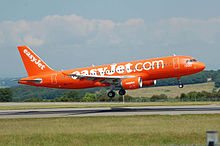Flatten out


The flare ( English landing flare , short flare , and flare-out ) is a maneuver which is a step in the landing of a plane is. It is between the interception (break) at the end of the flight phase of the approach ( final approach ) and the touchdown on the runway .
After the transition from the straight descent when approaching the ground was initiated by means of an intercepting arc (increased angle of attack , increased lift , reduced rate of descent) during interception, the angle of attack is increased further (the aircraft nose pulled up) and the flight speed at the same time reduced to further slow down the sink and achieve the correct angle of attack for touchdown. Conventional aircraft equipped with landing gears are designed in such a way that touchdown is carried out on all wheels at the same time or only on the main landing gear at first. Floating out usually only takes a few seconds.
With gliders that only have one wheel in the fuselage, floating out consists of leveling the aircraft by slowly and evenly pulling it at an altitude of less than one meter in order to reduce the flight speed (so-called starvation). In order to shorten the floating phase, the air brakes can also be extended evenly further before the main wheel and the spur are touched down at the same time.
When landing, a helicopter floats in order to reduce both vertical and horizontal speed and land almost vertically.
When paragliding and skydiving the lift-generating braking with the control lines is at the landing in front of the ground contact as interception or flare designated and three to five meters is approximately carried out over the floor.
Individual evidence
- ↑ Interception . In: Niels Klußmann, Arnim Malik: Lexicon of Aviation . 3. Edition. Springer, Berlin / Heidelberg 2012, ISBN 978-3-642-22499-7 , p. 3.
- ↑ Float away . In: Niels Klußmann, Arnim Malik: Lexicon of Aviation . 1st edition. Springer, Berlin / Heidelberg 2004, ISBN 3-540-20556-X , p. 26 (books.google.de) .
- ↑ Derek Piggott: Learning to fly a glider. The basics of motorless flight . Vieweg & Teubner, Wiesbaden 1980, ISBN 3-663-05285-0 , p. 65.
- ^ Simon Newman: Foundations of Helicopter Flight . Halsted Press, New York 1994, ISBN 0-470-23394-X , pp. 122 (English, books.google.de ): “… the final part of the autorotative maneuver. This is the landing flare prior to touchdown, which is necessary to arrest the vertical descent rate of the helicopter. "
- ^ Dan Poynter, Mike Turoff: Parachuting: The Skydiver's Handbook . Para Publishing, 2003, ISBN 1-56860-087-9 , pp. 68 (English, books.google.com - page not visible): “Flare at 15 ', push both toggles down to pelvis… or blow the timing on the landing flare.”
- ↑ Accompanying material for parachute jump training . Take Off Fallschirmsport Fehrbellin, as of 2016, accessed on April 16, 2017 (PDF).